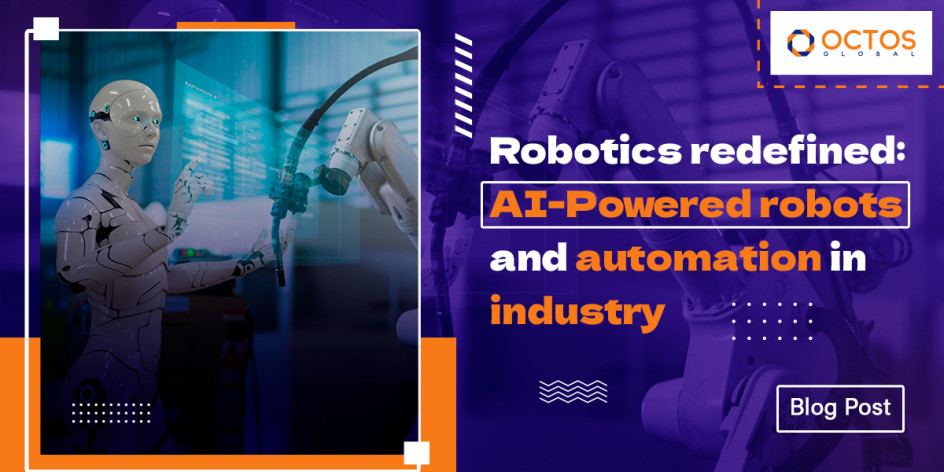Robotics and automation are transforming how industries operate. Robots are programmed to complete repetitive tasks with the same efficiency, and automation brings speed and accuracy to an industry.
When used together, these technologies have a significant impact on any organization’s operational capabilities and efficiency. Where industrial robots are taking over repetitive tasks, automation provides organizations with better flexibility and information accuracy to build better products and services.
While there are some cost challenges associated with both technologies, the benefits far outweigh the implementation costs.
Artificial Intelligence-Enabled Robotics
Artificial intelligence provides robotics with computer vision and understanding, which machines can use to navigate the right action and determine the right reaction. As a result, the machines gain capabilities that go beyond their simple tasks. AI helps machines interpret the vast amount of data they gather from sensors. This gives the robotic machines real-time awareness, and the robots can make quick decisions based on the data.
AI is integrated into all types of robots: articulated, cartesian, cylindrical, spherical, or SCARA. Specific programs and software are making these robots run according to the specifications. Several industries are using robotics and AI to gain competitive advantage. These include automotive, electronics, manufacturing, agriculture, and medical.
AI and Robotic Process Automation
Robotics and AI can handle routine tasks and enhance workflows. When organizations get robots to work for them, it helps them unlock new potential and become a market leader. Automated robots integrated with AI can take over mundane tasks and processes, ultimately increasing productivity and reducing the scope for error.
We are seeing automation being implemented beyond the usual industries like manufacturing, medical, automotive, etc. Today AI robots are automating several online shopping and shipping processes. From helping with package sorting to warehouse management, robotics, and AI are making their processes automated. In addition to this, these technologies are transforming the nature of work. As robotics and AI is integrated into the work process, robots and AI complement the work of humans. Because these machines have the capability to complete some tasks with better accuracy and efficiency, they can also become a coach for the human workforce.
Significant Operational Transition and Challenges with AI Robotics
Robotic process automation (RPA) is using software robots to automate repetitive business processes. As these robots perform different tasks with higher capabilities, they are also opening new avenues for the human workforce to improve their skills.
The way machines, robots, and artificial intelligence are augmenting people's skills and organizations includes;
Easy Compliance: With software running robots and automated machinery, it becomes easy to comply with the guidelines and create audit trails for quick analysis.
Speed: When machines can do the work with speed, it gives more time to humans to complete other, more important tasks.
Reliable: Any organization using robots and AI to complete operations can run their workplace round-the-clock while maintaining the desired productivity.
AI robots can also emulate several tasks and operations humans can perform and get better at decision-making and problem-solving. AI programs developed for robotics and automated processes learn to become better at their tasks. These systems rely on data they are provided by the users to complete their tasks.
The Future Course of Robotics and AI-Powered Automation
Robotics, automation, and artificial intelligence are already overhauling the way industries operate. In the future, human-robot interaction is only going to become better as more collaboration opportunities approach. Here are some future trends in AI robotics and automation.
Computer Vision: Robots can speed up the sorting process by identifying and recognizing objects. They learn the details of each product while being taught to avoid specific terms and items for easy processing and categorization.
Object Handling: Medical and pharmaceutical firms are already using robots to grasp medicine pills for packaging, sorting, and storage.
Natural Language Processing: Industry robots will gain a better understanding of their surroundings with NLP as they gain real-world perception.
Motion Control and Guidance for Navigation: Advancing into the future, robots won’t need human guidance to complete their operations. With AI, robots will become self-reliant in processing information, analyzing their environment, and self-navigating.
AI-based sensors are being increasingly integrated with robots. Additional advances in machine learning and AI will further enhance a machine’s intelligence.
Conclusion
Robots are set to change the world. Where on the one hand, robotics are being aggressively used in automotive, manufacturing, and processing industries, we are also seeing an increase in human-like functional robots.
Companies like Boston Dynamics are venturing into new domains and bringing us new possibilities while merging the gap between robots and humans. At Octos Global, we specialize in building digital solutions and software organizations can use to run automated and robotic machines.

